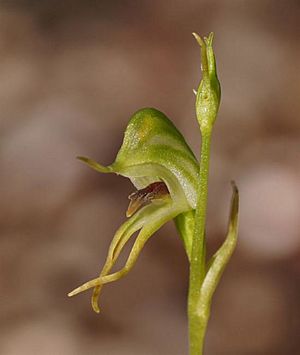Daintree's greenhood facts for kids
Quick facts for kids Daintree's greenhood |
|
|---|---|
 |
|
| Pterostylis daintreana in Vincentia | |
| Scientific classification | |
| Genus: |
Pterostylis
|
| Species: |
daintreana
|
| Synonyms | |
|
|
Daintree's greenhood (scientific name: Pterostylis daintreana) is a special type of orchid. It grows only in eastern Australia, meaning it's endemic there. This unique plant has interesting flowers that are mostly see-through white with cool dark green stripes.
When the plant is not flowering, it has a group of leaves called a rosette. These leaves grow close to the ground on short stems. When it's time to flower, a tall stem grows with up to ten flowers.
Contents
What Does Daintree's Greenhood Look Like?
Daintree's greenhood is a plant that grows from an underground tuber, which is like a small storage organ. It's a perennial plant, meaning it lives for more than two years. It's also deciduous, so some parts might die back in certain seasons.
Leaves and Stems
When the plant is not flowering, it has a rosette of three to ten leaves. These leaves are shaped like an egg or a heart. They are about 6 to 24 millimetres (0.2 to 0.9 inches) long. They are also about 4 to 13 millimetres (0.2 to 0.5 inches) wide.
Flowering plants have a stem that grows from 100 to 300 millimetres (3.9 to 11.8 inches) tall. This stem can have one or two rosettes of leaves on its side. It also carries three to ten flowers and three to five leaves along the stem itself.
Flowers
The flowers of Daintree's greenhood are quite unique. They are about 14 to 17 millimetres (0.6 to 0.7 inches) long. They are also about 4 to 5 millimetres (0.16 to 0.20 inches) wide. The flowers are a beautiful translucent white color with dark green markings.
The top part of the flower, called the dorsal sepal, and the petals are joined together. They form a hood-like shape over the central part of the flower, which is called the column. This dorsal sepal has a thin, thread-like tip that is about 3 to 4 millimetres (0.1 to 0.2 inches) long.
The side parts of the flower, called the lateral sepals, are joined near their bases. They then curve downwards and have narrow ends. These ends are about 7 to 8 millimetres (0.28 to 0.31 inches) long and grow parallel to each other. The labellum (a special petal in orchids) is dark brown. It is about 4 millimetres (0.16 inches) long and 2 millimetres (0.08 inches) wide. It also has two large lobes on its sides.
You can usually see Daintree's greenhood flowering from January to July.
How Was This Orchid Named?
The scientific name for Daintree's greenhood, Pterostylis daintreana, was first officially described in 1873. This was done by a scientist named George Bentham. He was helped by Ferdinand von Mueller.
They described the plant from a sample collected by Richard Daintree. This sample was found near Sydney. The description was published in a book called Flora Australiensis. The second part of the name, daintreana, was chosen to honor Richard Daintree, who collected the first sample of this plant.
Where Does Daintree's Greenhood Grow?
Daintree's greenhood can be found along the coast and in the tablelands of New South Wales. It also grows in southern Queensland. This orchid likes to grow among small shrubs or on mossy rocks.

